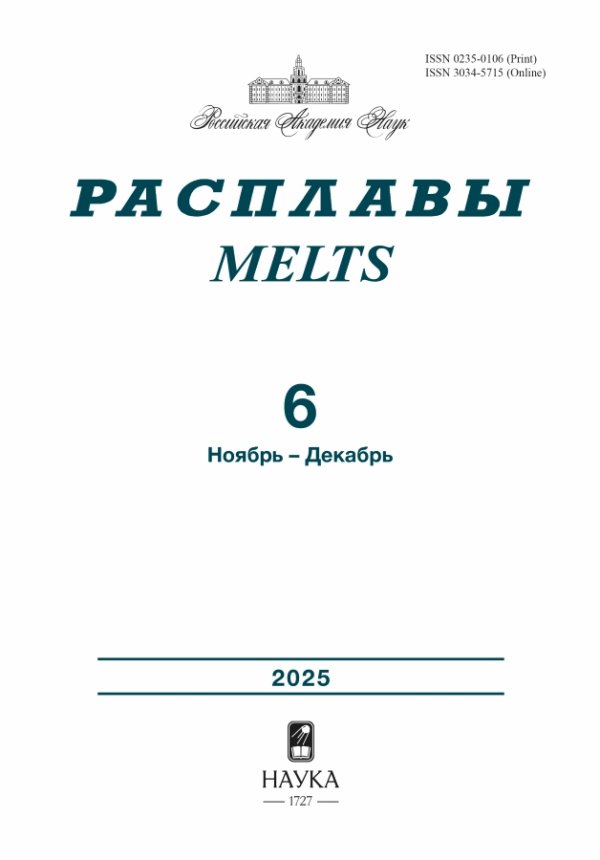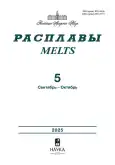Random two-dimensional ensembles of polygonal particles: densification and statistical-geometric properties
- Authors: Shubin A.B.1
-
Affiliations:
- Institute of Metallurgy of the Ural Branch of the Russian Academy of Sciences
- Issue: No 5 (2025)
- Pages: 430-443
- Section: Articles
- URL: https://bakhtiniada.ru/0235-0106/article/view/309549
- DOI: https://doi.org/10.31857/S0235010625050027
- ID: 309549
Cite item
Abstract
This study investigates the densities and statistical-geometric characteristics of random packings of regular polygons (with 3 to 21 vertices) on a plane. The initial ensemble was generated using the random sequential adsorption (RSA) method. A densification algorithm for the packing is proposed, which is a modification of the Lubachevsky-Stillinger (LS) method. The final ensemble was obtained by gradually increasing the linear dimensions of two-dimensional particles while keeping the density of the square «box» fixed. The statistical-geometric characteristics and packing density of the final ensemble (for a given number of polygon vertices) were found to be practically independent of the number of particles (for a total number of particles on the order of 10⁴ or more). Data on pair correlation functions were obtained, and the evolution of these functions was analyzed across a wide range of packing densities. At packing densities (area fraction occupied by particles) exceeding 0.65–0.70, characteristic features emerge in these functions, indicating a structural transition analogous to the glass transition in a system of hard disks. Further densification leads to partial «crystallization», which (at densities above 0.80) is clearly visible both in visualized images of the ensemble itself and in the correlation function plots. Overall, the evolution of correlation functions for hard disks and polygons (especially those with more than 6 vertices) exhibits several common patterns. The results of this study are in good agreement with those obtained in other studies using fundamentally different densification algorithms (e.g., sedimentation under gravitational force). This suggests that different algorithms for generating random 2D ensembles generally lead to similar outcomes. It appears that the general structural properties of random two-dimensional systems of convex particles are well reproduced across different generation methods (including computational and «physical» modeling).
About the authors
A. B. Shubin
Institute of Metallurgy of the Ural Branch of the Russian Academy of Sciences
Author for correspondence.
Email: fortran@list.ru
Amundsen St., 101, Yekaterinburg, 620016
References
- Brouwers H.J.H. A geometric probabilistic approach to random packing of hard disks in a plane // Soft Matter. 2023. V.19. P. 8465–8471. https://doi.org/10.1039/d3sm01254a
- Ciesla M., Barbasz J. Random packing of regular polygons and star polygons on a flat two-dimensional surface // Physical Review E. 2014. V.90. P. 022402. https://doi.org/10.1103/PhysRevE.90.022402
- Ciesla M., Kubala P., Zhang G. Saturated random packing built of arbitrary polygons under random sequential adsorption protocol //Physical Review E. 2019. V.100. P. 062901-1–062901-7. https://doi.org/10.1103/PhysRevE.100.062901
- Zhang G. Precise algorithm to generate random sequential adsorption of hard polygons at saturation // Physical Review E. 2018. V.97. P. 043311(1–5). https://doi.org/10.1103/PhysRevE.97.043311
- Ciesla M., Kubala P., Moud A.A. Random sequential adsorption of aligned regular polygons and rounded squares: Transition in the kinetics of packing growth // Physical Review E. 2023. V.107. P. 054904(1–7). https://doi.org/10.1103/PhysRevE.107.054904
- Duparcmeur Y.L., Troadec J.P., Gervois A. Random close packing of regular polygons // Journal de Physique I. 1997. V.7. № 10. P. 1181–1189. https://doi.org/10.1051/jp1:1997115
- Wang C., Dong K., Yu A. Structural characterization of the packings of granular regular polygons // Physical Review E. 2015. V.92. P. 062203(1–12). https://doi.org/10.1103/PhysRevE.92.062203
- Stannarius R., Schulze J. On regular and random two-dimensional packing of crosses // Granular Matter. 2022. V.24. № 25. P. 1–15. https://doi.org/10.1007/s10035-021-01190-7
- Aponte D., Estrada N., Bares J., Renouf M., Azema E. Geometric cohesion in two-dimensional systems composed of star-shaped particles // Physical Review E . 2024. V.109. P. 044908-1–044908-11. https://doi.org/10.1103/PhysRevE.109.044908
- Shubin A.B. Random ensembles of particles with pentagonal symmetry: densification and properties // Melts. 2025. № 1. P. 8–18. https://doi.org/10.31857/S02350106250102e3
- Meng L., Yao X., Zhang X. Two-dimensional densely ordered packings of non-convex bending and assembled rods // Particuology. 2020. V.50. P. 35–42. https://doi.org/10.1016/j.partic.2019.05.003
- Atkinson S., Jiao Y., Torquato S. Maximally dense packings of two-dimensional convex and concave noncircular particles // Physical Review E. 2012.V.86. № 3. P. 031302. https://doi.org/10.1103/PhysRevE.86.031302 (1–11).
- Shubin A.B. On the Maximum Density of Random Packing of Identical Hard Spheres // Rasplavy (Melts). 1995. № 1. P. 92–97.
- Shubin A.B. Concerning the geometric limit of the density of a loose medium modeled by identical spherical particles // J. of Engineering Physics and Thermophysics. 1995. V.68. № 4. P. 460–463. https://doi.org/10.1007/BF00858659
- Shubin A.B., Yatsenko S.P. Geometric constraints for the density limit in the two-dimensional model of liquid // Russian Journal of Physical Chemistry A. 1999. V.73. № 1. P. 140–141.
- Shubin A.B., Shunyaev K.Yu. Randomensemble of hard disks – limit density and statistical-geometric Properties // Rasplavy (Melts). 2006. № 5. P. 70–76.
- Shubin A.B. Structural characteristics of a small group of fixed particles and the maximum density of a random packing of hard spheres // Russian Metallurgy (Metally). 2021. № 2. P. 181–186. https://doi.org/10.1134/S0036029521020245
- Lubachevsky B.D., Stillinger F.H. Geometric properties of random disk packings // Journal of Statistical Physics. 1990. V.60. № 5/6. P. 561–583. https://doi.org/10.1007/bf01025983
- Zhang G. Precise algorithm to generate random sequential adsorption of hard polygons at saturation // Physical Review E. 2018. V.97. P. 043311(1–5). https://doi.org/10.1103/PhysRevE.97.043311
- Jiao Y., Torquato S. Maximally random jammed packings of Platonic solids: Hyperuniform long-range correlations and isostaticity // Physical Review E. 2011. V.84. P. 041309 (1–7). https://doi.org/10.1103/PhysRevE.84.041309
- Baranau V., Tallarek U. Relaxation times, jamming densities, and ideal glass transition densities for hard spheres in a wide range of polydispersities // AIP Advances. 2020. V.10. P. 035212(1–12). https://doi.org/10.1063/1.5140365
- Jin Y., Puckett J.G., Makse H.A. Statistical theory of correlations in random packings of hard particles // Physical Review E. 2014. V.89. P. 052207(1–9). https://doi.org/10.1103/PhysRevE.89.052207
- Donev A., Torquato S., Stillinger F.H., Connelly R. Jamming in hard sphere and disk packings // J. of Applied Physics. 2004. V.95. № 3. P. 989–999. https://doi.org/10.1063/1.1633647
- Blumenfeld R. Disorder criterion and explicit solution for the disc random packing problem // Physical Review Letters. 2021. V.127. P. 118002(1–5). https://doi.org/10.1103/PhysRevLett.127.118002
- Xu Y., Bares J., Zhao Y., Behringer R.P. Jamming Transition: Heptagons, Pentagons, and Discs // EPJ Web of Conferences. 2017. V.140. P. 06010(1–4). https://doi.org/10.1051/epjconf/201714006010
- Zhao Y., Bares J., Zheng H., Bester C.S., Xu Y., Socolar J.E.S. Behringer R.P. Jamming transition in non-spherical particle systems: pentagons versus disks // Granular Matter. 2019. V.21:90. P. 1–8. https://doi.org/10.1007/s10035-019-0940-4
- Kamien R.D., Liu A.J. Why is random close packing reproducible? // Physical Review Letters. 2007. V.99. P. 155501(1–4). https://doi.org/10.1103/PhysRevLett.99.155501
- Bayer M., Brader J., Ebert F., Lange E., Fuchs M., Maret G., Schilling R.,Sperl M., Wittmer J.P. Dynamic glass transition in two dimensions // Physical Review E. 2007. V.76. P. 011508(1–14). https://doi.org/10.1103/PhysRevE.76.011508
- Xu Y., Bares J., Zhao Y., Behringer R.P. Jamming transition: heptagons, pentagons, and discs // EPJ Web of Conferences. 2017. V.140. P. 06010(1–4). https://doi.org/10.1051/epjconf/201714006010
- Speedy R.J. On the reproducibility of glasses // J. of Chemical Physics.1994. V.100. P. 6684–6691. https://doi.org/10.1063/1.467028
Supplementary files









